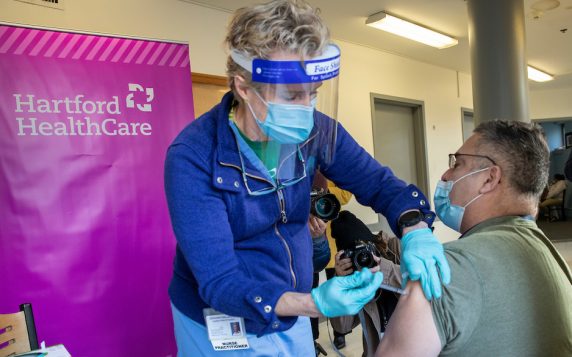Even if, as some health officials now hope, the Omicron variant might cause less severe infections than the now-dominant Delta or previous COVID-19 strains, its transmissibility makes it a formidable health threat.
“Well, we’re learning that it seems the Omicron variant is about 10 times more transmissible than the Delta variant,” says Dr. Manisha Juthani, Commissioner of the state Department of Public Health.
Delta combines high transmissibility — more than twice as transmissible as any variant before it — and virulence. Omicron emerged last month in South Africa, where it quickly created an exponential rise in cases. In a Hong Kong quarantine hotel, the variant spread across a hallway among two fully vaccinated travelers. Closed-circuit cameras confirmed they did not leave their rooms or have any contact.
“Anyone with Omicron infection can spread the virus to others,” says the Centers for Disease Control and Prevention, “even if they are vaccinated or don’t have symptoms.”
Researchers at the University of Hong Kong, in a study published last week in the journal Emerging Infectious Diseases, suggested only two possible means of airborne transmission: When the hotel rooms were opened for food service or, more likely, during COVID testing.
“Could it be milder? Could it be more contagious?” says Keith Grant, APRN, Hartford HealthCare’s Senior Director of Infection Prevention. “From the data we’re seeing, it seems to be a milder disease, a milder variant, and possible more contagious as well. It’s still too early to conclude.”
In the Tshwane district in South Africa’s Gauteng province, among the first areas in the world where Omicron replaced Delta as the dominant COVID-19 strain, noted the dramatic rise in cases was not accompanied by a significant increase in hospitalizations and deaths. Between Nov. 14 and Nov. 29, only one COVID-19 patient required oxygen — for a separate, non-COVID illness — according to a report published over the weekend by the South African Medical Research Council.
Still, it could take at least two more weeks for a clearer indication of Omicron’s severity. Although it’s possible Omicron’s multiple mutations on the spike protein will make it more resistant to current vaccines and natural immunity, some medical experts say the mildness of infections could be attributed to the vaccine.
“You have much stronger secondary immune stimulation when it comes to the vaccine,” says Dr. Ulysses Wu, Hartford HealthCare’s System Director of Infection Disease and Chief Epidemiologist.
Second Omicron Case; State’s Positivity Rate at 8.3 Percent
A fully vaccinated Fairfield County man in his 20s became the state’s second confirmed Omicron case, state officials said Dec. 7. The man traveled to New York City a week before his symptoms started, but he did not attend the Anime NYC 2021 convention, site of an earlier outbreak.
Connecticut officials over the weekend reported the state’s first Omicron case, a fully vaccinated Hartford County man in his 60s who developed mild symptoms Nov. 27, had a positive at-home test Nov. 29 and then a positive molecular test Dec. 1. A family member had attended the Anime NYC 2021 convention.
Meanwhile, Connecticut’s COVID-19 positivity rate spiked 8.3 percent Dec. 7, among the highest rates of the past year.
The rate Dec. 6 was 5.8 percent.




